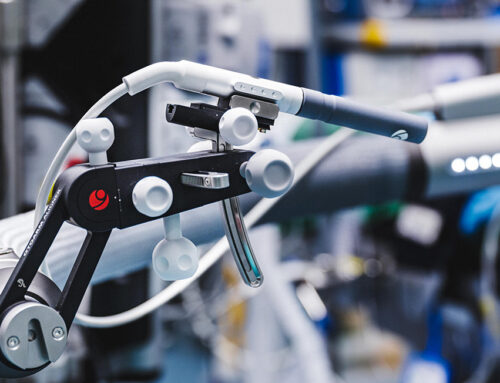How cochlear implants and other hearing implants help with otosclerosis
In 10 to 15 percent of all people affected by otosclerosis, neither hearing aids nor stapes surgery restore hearing ability. For them, hearing implants are a good alternative, most often cochlear implants.
Eva Kohl and Yi Ge

©Adobe Stock
In 1893, the Viennese otologist Adam Politzer first described otosclerosis as an independent disease. It usually begins at the transition between the middle ear bones and the inner ear, between the stapes and the oval window. The bone transforms into a jelly-like mass, which is why the disease is also called otospongiosis. This damage spreads and ossifies, causing the structures there to stiffen. This leads to increasing conductive hearing loss and, more rarely, to sensorineural hearing loss. Sometimes this develops in functional or complete deafness.
In many cases, conventional hearing aids or surgical replacement of the stapes with a prosthesis can restore hearing. However, in about one in seven to ten affected persons, these measures are unsuccessful: for them, active hearing implants remain an option.
Among people with otosclerosis, an average of 16 years pass between the onset of hearing loss and the recommendation of a cochlear implant. The duration of deafness is an important factor for later hearing success with a CI. Although the implant cannot stop the progression of the disease, it maintains the function of the auditory nerve. In any case, those affected can expect significant improvement in hearing with a CI, especially with early implantation.
Spread, progression, and effects of otosclerosis
The typical otosclerosis patient is female, white and between 15 and 45 years old. Men and people of other ethnic backgrounds are less frequently affected. The first symptoms can appear during hormonal changes, for example during pregnancy, after an infectious disease such as measles, or after strong noise exposure. A genetic connection is also being discussed. Remarkably, nine out of ten people with otosclerosis remain completely free of symptoms despite excessive bone and tissue growth in the skull around the middle ear.
If symptoms appear, the first sign is usually conductive hearing loss for low tones, which then worsens continuously over years or decades. A typical characteristic is the so-called paracusis Willisii, named after the English physician Thomas Willis. Speech is understood better in noisy surroundings than in quiet ones. In up to one third of those affected, the ossification later spreads to the inner ear, causing mixed or sensorineural hearing loss. If the inner ear (the cochlea) becomes particularly heavily ossified, this is called cochlear ossification.
Otosclerosis usually affects both ears, though not always to the same degree. Most people affected also develop ringing in the ears, known as tinnitus; about 40 percent also suffer from mild dizziness. In 10 to 15 percent of those affected, the ossicles remain movable, but the tissue growth produces substances that damage the inner ear and lead to sensorineural hearing loss – this is referred to as inner-ear otosclerosis.
Implants – an important alternative in treatment!

Yi Ge, MD, Senior Manager for Medical Affairs at MED-EL: “If neither hearing aids nor stapedectomy can restore hearing, people with otosclerosis can usually benefit optimally from various implant systems.” © private
ENT specialists often pursue a “watchful waiting” approach for patients with otosclerosis. Conventional hearing aids are intended to compensate for mild hearing limitations. For patients with significant conductive hearing loss, good results are often achieved through stapedectomy (stapes surgery): the stapes is one of the three middle ear bones and is usually where the ossification begins. During stapes surgery, it is partially or completely replaced by a prosthesis, also known as a passive middle ear implant.
However, 10 to 15 percent of patients do not regain satisfactory hearing, either with hearing aids, after surgery, or with a combination of both. “Unfortunately, there is still no consensus on how such patients can be treated most effectively,” explains Yi Ge, MD, Senior Manager for Medical Affairs at the implant manufacturer MED-EL. “In most cases, these patients can benefit optimally from various implant systems.”
In fact, among people with otosclerosis there are suitable candidates for nearly every implant system. For the large group with purely or predominantly conductive hearing loss, the bone-conduction implant BONEBRIDGE is particularly suitable. But once hearing loss in an ear meets the criteria for a CI, this becomes the most promising alternative.
For otosclerosis as well: timely implantation is important!
Otosclerosis involves excessive growth of soft tissue called fibrosis, and of bone, called osteogenesis. This can present a surgical challenge during the insertion of a CI electrode. The unique planning tool OTOPLAN is in this case especially useful: it allows surgeons to plan the implantation of MED-EL hearing systems and even determine the optimal length of the electrode array. The large selection of electrodes enables precise adaptation to the individual length of the still-unossified part of the cochlea, thereby preserving valuable structures for later speech understanding with the CI.
Otosclerosis is a progressive process and the resulting hearing impairment progresses as well. Cochlear implants, like hearing aids, stapes surgery, or other hearing implants, are intended to improve hearing and speech understanding. However, they cannot slow down or stop the excessive bone growth. The disease can continue to develop slowly in the background and may influence the long-term hearing outcome with the CI. Nevertheless, electrical stimulation helps preserve the function of the auditory nerve and prevent further degeneration. [1] [2] [3]
People with otosclerosis have been shown to achieve good hearing outcomes with cochlear implants. [4][5]Although cochlear implants require a period of adaptation and auditory rehabilitation, studies show that, with the right indication, CIs lead to significantly higher satisfaction among otosclerosis patients than stapes reconstructions. [6]The factors influencing good hearing with a CI appear to be the same as for other CI users. Among other things, the shorter the period during which the affected ear could no longer hear, the better the results. It is therefore hard to understand why people with otosclerosis still have to wait an average of 16 years until a CI finally brings hearing back to the silent ear.
[1] Kopelovich JC, et al. Intracochlear electrical stimulation suppresses apoptotic signaling in rat spiral ganglion neurons after deafening in vivo. Otolaryngol Head Neck Surg. 2013 Nov;149(5):745-752. doi: 10.1177/0194599813498702.
[2] Chen I, et al. The effect of cochlear-implant-mediated electrical stimulation on spiral ganglion cells in congenitally deaf white cats. J Assoc Res Otolaryngol. 2010 Dec;11(4):587-603. doi: 10.1007/s10162-010-0234-3.
[3] Fallon JB, et al. Effects of chronic cochlear electrical stimulation after an extended period of profound deafness on primary auditory cortex organization in cats. European Journal of Neuroscience. 2014 March; 39(5):811-820. doi: 10.1111/ejn.12445
[4] Skarzynski PH, et al. Outcomes of Cochlear Implantation in Patients with Far-Advanced Otosclerosis Who Had Previously Undergone Stapes Surgery. J Int Adv Otol. 2024;20(2):101-107. doi:10.5152/iao.2024.231332
[5] Assiri M, et al. Cochlear implantation among patients with otosclerosis: a systematic review of clinical characteristics and outcomes. Eur Arch Otorhinolaryngol. 2022;279(7):3327-3339. doi:10.1007/s00405-021-07036-5
[6] Kondo M, et al. Cochlear Implantation in Far Advanced Otosclerosis: A Systematic Review and Meta-Analysis. Laryngoscope. 2023;133(6):1288-1296. doi:10.1002/lary.30386






